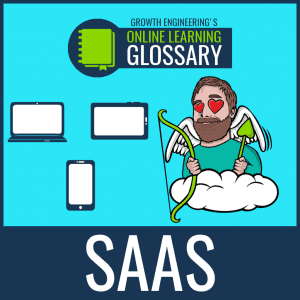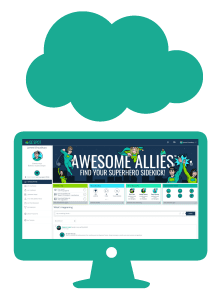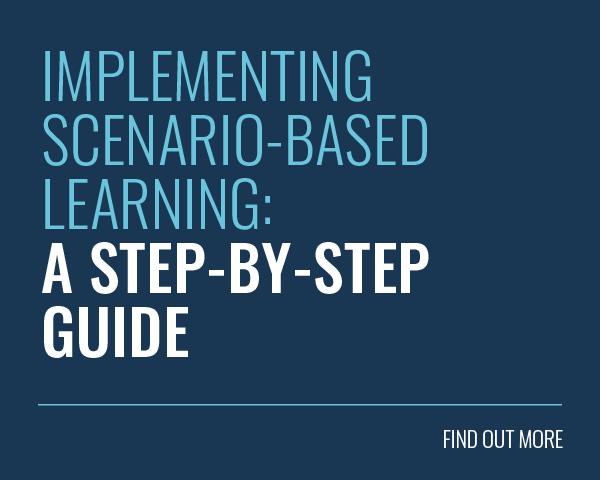 SaaS is a key piece of jargon that you’re likely to come across when looking into learning management systems, and it has a lot to do with that elusive ‘cloud’.
SaaS is a key piece of jargon that you’re likely to come across when looking into learning management systems, and it has a lot to do with that elusive ‘cloud’.
Ever since the dawn of mankind, clouds have been an ominous sign. They’ve signalled that storms are coming, raining down destruction upon crops and dooming those at sea to a watery grave…
But thankfully a silver lining has emerged in the form of cloud computing! This is a term which has been around for decades, but you’ve probably noticed it really coming to prominence over recent years, as it’s started to affect almost every area of technology.
Let’s take a look at how SaaS fits into our cloudy skyline, and why it’s good for learning and development!
SaaS
 Traditionally, using software has required you to download and install programs on your computer. This takes time, uses up storage, and requires the user to have a device which is capable of actually running the program in the first place.
Traditionally, using software has required you to download and install programs on your computer. This takes time, uses up storage, and requires the user to have a device which is capable of actually running the program in the first place.
Enter SaaS, otherwise known as Software as a Service! This is software which is hosted and distributed via the cloud. Contrary to what you might think, the cloud doesn’t actually exist up in the sky, but is rather a network of servers.
So a SaaS product is installed and hosted within a single place – this network of servers. Customers can then access it from their devices by using a web browser, or an app, without having to install the full product and host all of the data themselves.
This is a huge convenience and basically means that anyone can access the product as long as they have a decent internet connection! It also means that customers don’t need to worry about support and maintenance since all of this can be handled by the system provider.
10 Advantages of a SaaS LMS
Most learning management system providers have caught on to the popularity of SaaS, and so they offer cloud-based products to their customers. Let’s take a look at some of the benefits of a SaaS LMS:
1. Demo
You’ll want to take a good look at a few LMSs before you settle on the perfect one for you. With a SaaS platform, it’s easy to set up a trial or sandbox platform for you to play around with. This will let you tinker with the system first-hand and explore all of its nooks and crannies, so that you can be sure that it’s the one!
2. Quicker setup
Once you’ve chosen your system, you’ll find that a SaaS platform is much quicker to set up than an on-premises system. The product is already set up and hosted, so you just need to customise it to suit you, and fill it with your training content. Also, hosting it in the cloud means that both the customer and provider can log in to configure it, allowing the provider to assist more directly in the setup.
3. Access anywhere, any time
 Once the platform is up and running, your learners will be able to access it whenever they need to. With a cloud-based LMS, they don’t need to be at the office and connected to the server. Whether they’re at home or on their commute, they can log on to the system whenever they need to!
Once the platform is up and running, your learners will be able to access it whenever they need to. With a cloud-based LMS, they don’t need to be at the office and connected to the server. Whether they’re at home or on their commute, they can log on to the system whenever they need to!
4. Access from any device
As well as the freedom to learn whenever they want, your learners will appreciate having the freedom to use whichever devices they happen to have to hand. Traditional systems which required installations would only work on specific computers. But as long as your new LMS uses responsive design, it can be accessed from any internet browser as long as the learner has an internet connection.
5. Stream content
eLearning units and video files are big, so distributing them can be a pain. Older systems often used CD-ROMs, or required learners to download files before accessing them. But streaming content from the cloud is quick and easy, and doesn’t put too much strain on your learners’ computers.
6. Automatic updates
When organisations had to purchase and host systems themselves, updating them could be difficult. Often, you would be stuck with the version you bought, and would have to pay for an upgrade a few years down the line. Since a SaaS LMS is hosted in one place, the provider can update it easily. And because the customers are accessing their platforms from this same location, they’ll find that all of the latest functionality has been given to them without even having to lift a finger!
7. No IT headaches
With a SaaS LMS, you remove the bulk of IT issues that your organisation needs to deal with directly. You don’t need to help all of your learners to install the software, you don’t need to work on updates or maintenance yourself, and you can push support queries towards the system provider for them to deal with.
8. Better support
Speaking of support, it’s much easier for providers to support their customers when they offer a SaaS product. Since everyone is using the same version of software, it becomes much easier to diagnose issues when they arise. Also, when a problem is fixed for one customer, that same fix will work for everyone else.
 9. Cheaper
9. Cheaper
A SaaS LMS should work out considerably more cost-effective than one you host yourself. You don’t need to pay for your own servers and storage, and you pay for what you use rather than buying everything the product has to offer in full.
10. Scalable
When you purchase a system that you need to install and host yourself, you’re pretty much stuck with the limits of the hardware. With a SaaS platform on the other hand, scaling up or down is easy to do. So if you suddenly find yourself having to deliver training to double the number of learners, your LMS should be able to handle it without any problems!
Keep an eye out for plenty more entries into our Online Learning Glossary over the coming weeks!
And if you’re looking to put together a massively successful online training programme, then you’ve come to the right place! Download your free Engagement Engine Workbook to map out a strategy which uses gamification, social and personalised learning:








